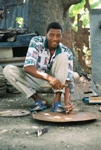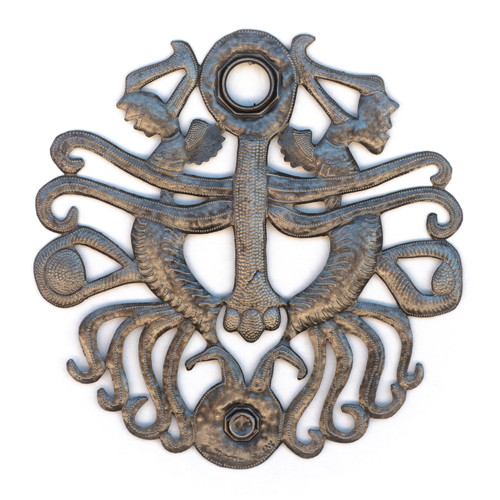Product Description
The Haitian spirit of "The Fierce Mother - Erzulie Dantor" is represented by a heart pierced with a sword. This symbol is drawn onto temple floors during religious ceremonies to summon her presence. Meda Ulyssee has recreated that symbol in recycled metal. Of course, he had all of the cultural background to communicate its meaning with hammer and chisel, but we had to learn the story before we could fully appreciate the significance he struck into every detail. What we called simply ”Meda’s Heart” is actually much more. On a pure and elemental level, it is a beautiful representation of the strength of a mother’s love.
Erzulie Dantor is a bi-racial woman who is often portrayed as the Black Madonna, or the Roman Catholic "Saint Barbara Africana". She has three tribal scars on her cheek. Erzulie Dantor is fiercely protective of those who serve her. She can be aggressive toward outsiders and dangerous to enemies, but she is sweet as honey to her children. Magical ability and material wealth are both in her power to grant, she is also invoked to avenge wrongs done to those who serve her. Women invoke her in cases of domestic violence and rape, and Dantor is widely considered the patron lwa of lesbian women. Yet heterosexual women, and all men, serve her assiduously as well, for the sake of the protection she grants them.
It's Cactus Metal Art Haiti
Artist Bio

Meda Ullysse
Whether born into one of the artisan families of Croix-des-Bouquets, or drawn from the Haitian countryside by the prospect of education and work, It's Cactus 80-plus sculptors know that their futures are secured by art, tradition, and fair trade. Beginning in the 1950s with Georges Liataud, the former railway blacksmith turned folk art pioneer, creativity and innovation have gone hand in hand with teaching and sharing. Liataud, observing the surplus of steel drums in his village, saw opportunity and resources. He cut the metal barrels, using only a hammer and a chisel, and began fashioning simple crosses to mark gravestones in the local cemetery. His work attracted the attention of DeWitt Peters, founder of the Center d’Art in Port-au-Prince, who brought him into the Center and encouraged him to explore his craft. Taking that advice, Liataud expanded his repertoire and began depicting cultural as well as religious images. Additionally, he experimented with dimensionality and form. Equally important, he began to share his knowledge, taking on Gabriel Bien-Aime and the Louisjuste brothers as apprentices. And those men, now regarded as great masters in their own right, taught the next generation, who in turn taught the next. So it is today, with several It's Cactus artists having trained with these early master sculptors, now opening their own workshops, and sharing their techniques with the young and eager. As one artist put it, “I teach people how to work. When I hire them, I help them to earn a life.”
Casey Riddell, founder of It's Cactus takes the artists through the next steps. By collaborating with them on design creation, placing orders, paying fair wages, and taking Haitian metal sculptures to the global market, great strides are made in helping the craftsmen of Croix-des-Bouquets help themselves. Guided by cultural respect and conscientious business practice, It's Cactus and its Haitian partner artists work toward their mutual goals of uplifting lives.















